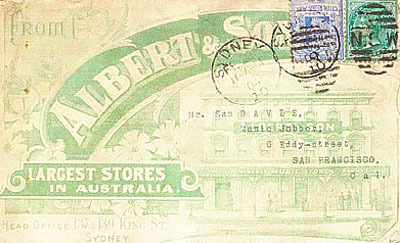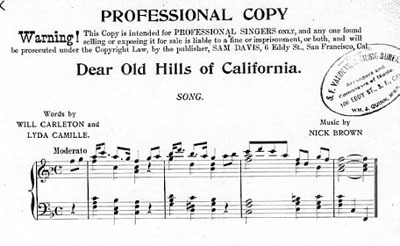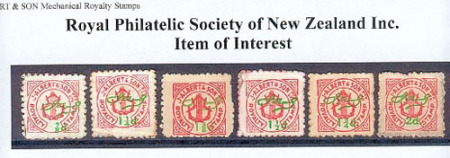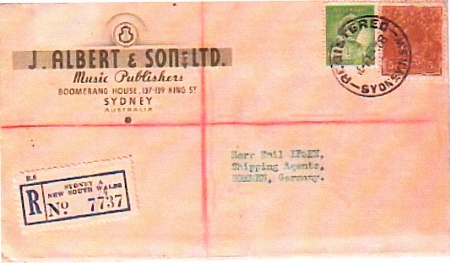This advertising cover “From Albert & Son, Largest Stores in Australia, Head Office 137 & 139 King St. Sydney” is in a pale dull green print, shows a picture of a three level store and on the front of its awning ‘ALBERTS MUSIC STORES SYDNEY’. A total of 2½d NSW stamps are attached and postmarked with 2 copies of SYDNEY/ FE 22/ 11-A-M/ 04/ 10 N.S.W duplex. It is addressed to Mr. Sam Davis, Music Jobber, 6 Eddy-street, SAN FRANCISCO, Cal (Figure 1).

The addressee has been identified as the publisher of a popular song, the “Dear Old Hills of California” and Sam Davis’ name and address have been confirmed in the third line of the Warning. The music was copyrighted in 1905 by Sam Davis, and a portion of the music is shown in Figure 2.

Jacques Albert, a Swiss-born music teacher migrated to Australia in 1884. He and his son Michel Francois (Frank) established the Albert Music business in 1890 when they began to import violins. In the early 1900’s Albert’s became one of the leading sheet music publishers in Australia. They published the Boomerang Songster, containing the lyrics of popular songs, bought the Australian rights to songs by Cole Porter, Irving Berlin and other songwriters of the 1920’s to 1940’s, and acted as the local agent for many overseas publishers.
The business was carried on by Jacques, his son Frank, his grandson Alexis (later Sir Alexis) and his great-grandsons Ted and Tony (now both deceased) and Robert. Until 1995 J.Albert & Son also owned one of Australia’s largest radio networks, which included radio station 2UW. Ted Albert became interested in building an Australian catalogue to complement Albert’s international repertoire. A new division was established, Albert Productions, to enable them to expand beyond their music publishing activities into record production.
The Albert’s roster of music dominated Australian pop music in the late 70’s and early 80’s. The family business was very successful financially and Frank built a Spanish mission house on the waterfront at Elizabeth Bay in the 1920’s, which sold just recently for A$21 million. In 1989 Ted Albert decided to move into films, but he died in 1990 before realising the completion of his new project, but his wife carried on his vision to completion.
There is a somewhat peripheral ‘philatelic’ interest to the Albert & Son company for the Royal Philatelic Society of New Zealand sold in 1947 the following item for NZ$20 described as:
“Mechanical Royalty stamps (ex 78rpm records), J.ALBERT & SON 1937-40’s vermilion & green assorted values to 2d. Issued to show the payment of composer’s royalties and affixed to labels of records.” (Figure 3).

I wish to acknowledge the research performed by Judy Nelson, Mitchell Library, Sydney who provided the history about this highly successful Australian Music business family.
Addendum (September 2007): This registered cover from Sydney to Bremen, Germany is another example of Albert & Son’s international scope (Figure 4)
